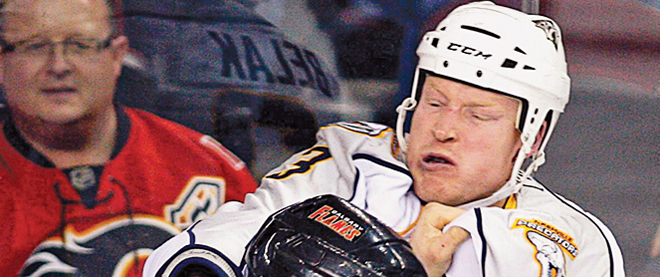Why it’s time to retire the enforcer
The NHL enforcer’s career is nasty, brutish, and often short
Jeff McIntosh/CP
Share

Imagine a job has become available at the office of your dreams. The description is straightforward: all you have to do is pick a fight every day with someone you’re not angry at and you don’t necessarily dislike. You make a fraction of what your co-workers make and every fourth day or so you incur an injury that could culminate in a degenerative brain disease conducive to depression—or worse. But there’s a perk: you get to work in the office.
Meet the NHL enforcer—an unpopular position of late, and the subject of innumerable Canadian media debates following the “apparent suicides” or “accidental deaths” of hockey tough guys Derek Boogaard, Rick Rypien and, most recently, 35-year-old Wade Belak. New York Ranger Derek Boogaard was just shy of his 29th birthday when a lethal mix of alcohol and oxycodone took his life in May. Winnipeg Jet Rick Rypien, 27, was found dead in his Alberta home in August, after more than 10 years of battling depression. Wade Belak, retired enforcer and father of two, apparently committed suicide in a Toronto hotel/condominium on Aug. 31.
The majority of people in sports, from broadcasters to bloggers and NHL players themselves, are loath to concede a connection linking the deaths. Any three people in any profession, they argue, could have ended their lives within a few months of one another for reasons unrelated to their line of work. As usual, they contend, the media’s impulse to equate hockey violence with depression is sensational journalism at its worst.
Arguments like these don’t just carry a whiff of self-service; they’re obtuse to the point of dishonesty. Because though we may never know exactly why these enforcers hit rock bottom, one fact remains indisputable: the only people who can offer any credible explanation for their deaths are—or once were—enforcers themselves. It doesn’t matter that there’s dissent among the ranks (Toronto enforcer Tie Domi, for example, chalks the timing of the deaths up to pure chance). There’s enough “tough guy” testimony to prove that if hockey violence doesn’t necessarily make players kill themselves, it at least makes them think about it.
“This is me,” former “goon” Jim Thomson told CTV in the wake of Belak’s death. “I’m not saying anything about Wade or the other guys who have died but I’ve thought about many times of taking my life.” Echoing Thomson is retired Montreal Canadiens heavyweight Georges Laraque. “I used to feel that way in my first couple years,” he said in a 2009 blog posting. “I used to not be able to sleep before games and I would sweat in the afternoon. Sometimes I was even praying that the other guy—or even me—would be scratched so the fight wouldn’t happen.”
Herein lies the heart of the dishonesty. We can defend hockey violence all we want, but as long as we insist it’s spontaneous desire that makes an enforcer fight, and not his duty, we’re all accomplices in sacrificing these young men in the name of the game we supposedly love. The role of enforcer is comparable to sentry man or prison guard. Antagonism, aggression and yes, fear, aren’t by-products of the job, but the job itself. Yet it seems to be beyond the moral imagination of the NHL to realize that when a job requires you to be consistently brutish, even when you’re not, depression—even suicide—may not be far off.
The late Bob Probert and Reggie Fleming were both veteran enforcers whose brain autopsies showed chronic traumatic encephalopathy—a progressive degenerative brain disease associated with erratic behaviour and depression. And Probert and Fleming played in a different time—before staged fights between designated tough guys were celebrated and glorified. Chances are the numbers of damaged brains have increased since then. Jim Peplinski, once a renowned fighter with the Calgary Flames, considers today’s premeditated fighting a possible cause of the emotional hazards described by Laraque and Thomson. “I never held any intentional premeditation,” he told the Globe and Mail recently, “that there was going to be a fight. Sometimes, it happened. What I see today is different than that.” What he sees is something more sinister: men who will themselves to fight. Even professionals who are wary of tying hockey fights to suicide hear the tolling of something ominous: “Facing violence on a nightly basis,” says sports psychologist Saul Miller, “may stress the soul.” It may also destroy it.
The shock and pain of the families involved notwithstanding, the prevailing “surprise” of the hockey world that the happy-go-lucky attitude of Belak contradicts his death is simply misinformed. It is well known among psychologists that when depressed people suddenly feel better, it may be a warning sign they’re actually strong enough to act on suicidal thoughts. Unfortunately, no one in hockey picked up on Belak’s plucky spirit for what it might have been: a bad omen. But there’s intuition and then there’s the NHL. The league has promised to conduct a “review” of the tragedies, but no amount of suicide awareness will help while the role of enforcer remains strong within the league. If the NHL cares more about its players’ welfare than saving face and filling seats, it will say goodbye to the goon forever. I’ve played hockey all my life, and I’ve been nervous going into plenty of games. But my nervousness was leavened with a certainty: I knew I was going to play a game—I wasn’t going to war.